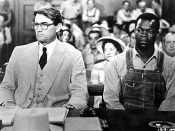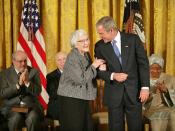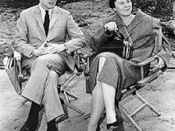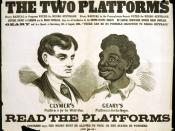Harper Lee's "To Kill a Mockingbird" takes place in a small southern town of Maycomb, Alabama during the early 1930s, where prejudice was at its peak. The story unfolds through the eyes of a six-year-old girl named Scout Finch. The universal truth applied in this book is the different forms of prejudice existing in a discriminatory society. The setting of the novel enables us to come to a better understanding of why certain events happen under the circumstances and eventually inform us about the theme.
Maycomb, a typical small town in southern Alabama, has the prejudicial attitude which triggers many incidents and also establishes the status of people. Most people have the same beliefs and values in the community of Maycomb. There is a strong division of classes within Maycomb and the rigid class structure has an extensive effect on the events. For instance, Scout condescends to Walter Cunningham when she is explaining to Miss Caroline about his situation.
Scout judges Walter based on his family and she is labeling him as the "Cunningham family" which is seemingly meant to be poor and poverty. When Scout tells Miss Caroline about the Cunningham, she thinks it is "clear enough" (24) to the rest of the people. The story is set during the Great Depression, at a time in which millions of Americans lost their jobs. Many people lost their homes, their land, and their dignity. Burris Ewell is not accepted in Maycomb as well. The class says to Miss Caroline that he is "one of the Ewells" (31) and that the Ewells are "members of an exclusive society made up of Ewells" (35). Gossips can affect key events and even the smallest details because they make everyone to prejudge others. To some degree, it is all under Maycomb's definition system.
Unfortunately, the Great Depression changed public attitudes and created racist mentality as well as segregation. The Radley are differentiated from the community by their isolation from the patterns of social interaction, which causes the town to slander Boo Radley. This is also a form of segregation system in Maycomb. Boo is interpreted in their own imaginations. People believe that "any stealthy small crimes committed in Maycomb were his work" (13) and they are "unwilling to discard their initial suspicions" (13). Racism was common in the Southern states at this time. The way in which Maycomb reacted to Atticus' decision of defending Tom Robinson reveals the extent of the town's racist attitude. This is seen through the dialogues of children who seem to have been indoctrinated into the inequitable beliefs and have picked up several disparaging comments towards Atticus. Atticus is said to be a "nigger-lover" (87) and he is "ruining" (87) the family. However, Scout is growing up as a more considerate person under the influence of her father. Atticus wants to stop the "usual disease" (93) of prejudice from spreading further in Maycomb. By giving the advice to Scout, Atticus therefore is referring to the people in Maycomb "never really [understanding] a person" (34) because they never "climb into his skin and walk around in it" (34). A mockingbird is a harmless bird that makes the world more pleasant by "singing their hearts out" (94) and making music for us to enjoy. Harper Lee uses the term, mockingbird, to reveal the "sin" (94) of prejudice and problem of racism in the South.
The setting acts as a superb backdrop to the deeply rooted prejudice where the theme is revealed. United States proudly professed democracy but sadly practiced the antithesis of democracy. Under the years of the Great Depression in the South, it is the varying forms of discrimination that results the prejudicial attitude people have towards others.





